 |
FIELD TRIPS AND POST
TOUR
Two post-conference
field trips are being organised:
- Grande Terre Post Conference Tour (4 days), and
- CANCELLED - Loyalty Island Post Conference
Tour (2 days) - CANCELLED
Four one day field trips are being planned:
1. Ultramafic maquis of the Southern region - 1h30 from Nouméa,
2. Koniambonickel Mine in the western north coast - 3h from Nouméa,
3. Parc des Grandes Fougères in the Central Chain Mountains - 1h30 from Nouméa,
4. Mount Aoupinié and Gohapin tribe in the in the Central Chain Mountains - 2h30 from Nouméa
Scroll down for more information about these
field trips.
Sunscreen (30+), hats and enclosed flat shoes
(sports shoes or similar), are required for all field trips.

SERA 2014 Grande Terre Post Conference
Tour
Take a round trip on Grande-Terre to discover
the amazing landscapes of the West and East coasts and the central
chain. This 4-day (3 nights out of Nouméa) journey will be the opportunity
to have a close look at New Caledonia's main vegetation types (dry
and humid forests, maquis minier) and to comprehend the main threats
(bush fires, invasive species, mining...) linked to these ecosystems.
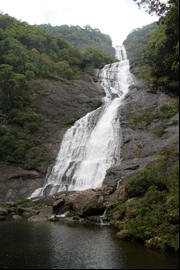 Along
with sightseeing, you will be able to meet local people and specialists
and to learn about their will to protect their environment. You
will also be pleased to meet New Caledonia's biodiversity hotspot
world famous native flora (Amborella) and many more. Along
with sightseeing, you will be able to meet local people and specialists
and to learn about their will to protect their environment. You
will also be pleased to meet New Caledonia's biodiversity hotspot
world famous native flora (Amborella) and many more.
Read the itinerary
for more information...
22-25 November 2014
4 days and 3 nights
72 000 XFP (i.e. 603 €)
Maximum of 30 participants
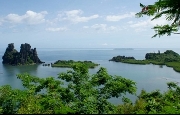
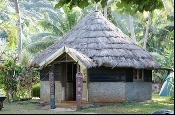
Left - Hienghène "Hen" © E. Bonnet-Vidal
Centre - Melanesian Hut © E. Bonnet-Vidal
Right - Colnett Fall

SERA 2014, Loyalty Island Post Conference Tour CANCELLED

ONE DAY FIELD TRIPS - Thursday 20
November 2014
The conference program includes a one-day mid-conference
excursion (Thursday 20 November 2014).
Choose and discover one of
the examples of ecological restoration projects in Grande Terre,
the main island of New Caledonia.
Sunscreen (30+), hats and enclosed flat shoes (sports shoes or similar),
are required for all field trips.
PLEASE NOTE: One-day field trips will not be cancelled if rain is
forecast.

FIELD
TRIP 1: Ultramafic maquis of the Southern region - 1h30m from
Nouméa
The plain of lakes is located in the southern part of the Grand
Massif du Sud at an elevation of 250m above sea level, between the
Yaté Lake and the Goro Plateau. The tour features spectacular views
of southern mountains ranges and its lake systems along with forestry
plantations of Agathis and Araucaria. Visits in the
morning will include the Araucaria arboretum (at Riviere
Bleue Reserve) - optional, Madeleine falls nature Reserve, home
to New Caledonias world-renowned riparian gymnosperms (Dacrydium
guillauminii, Neocallitropsis pancheri, Retrophyllum minor)
and Vale New Caledonias native species nursery. Lunch at the nursery
will be followed by a visit to Vale New Caledonia revegetation sites
on the Goro plateau situated at 300m above sea level.
The trip is suited to everybody. Walking shoes, long trousers, sun
cream and a hat are recommended.
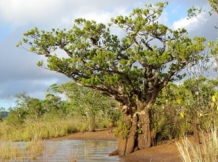
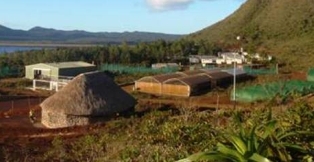
Left: Retrophyllum minor 2m
Right: Vale native species nursery

 FIELD
TRIP 2: Koniambonickel Mine in the western north coast - 3h
from Nouméa FIELD
TRIP 2: Koniambonickel Mine in the western north coast - 3h
from Nouméa
The visit on the Koniambo massif will illustrate ecological restoration
activities on a young open pit mine of 1500 hectares operated by
Koniambonickel (Glencore - XSTRATA / SMSP). Rehabilitation activities
face a challenging environment characterized by a high biodiversity
of flora species (>80% endemism and many micro endemism), topography
with 15%-20% average slope on pit, and a dense surface water network
associated with low rainfall climate.
The tour is accessible to anyone and will give an overview of our
mining operation, as well as our rehabilitation activities from
mangrove to the top of the mine where a unique vegetation of shrubland
dominated by Araucaria montana species, and relic of humid
forest down the valley is established.
 
Top: Koniambonickel Mine
Left: Restoration activities
Right: Rehabilitation mangrove

FIELD
TRIP 3: Parc des Grandes Fougères in the Central Chain Mountains
- 1h30m from Nouméa
Dedicated to the conservation of 4,535 hectares of rainforest, the
"Parc Grandes Fougères" straddles the 3 typical villages of Moindou,
Farino and Sarraméa. The park aims to offer visitors relaxation
and discovery of quality. Included in the terrestrial buffer zone
of the West Coast inscribed at the UNESCO World Heritage list, it
extends on volcano-sedimentary rocks at altitudes ranging between
400 and 700 meters.
In terms of biodiversity, it is estimated that 500 species of plants,
of which 70% are endemic, are found in the Parc des Grandes Fougères
such as several species of endemics fern trees and palms. Also,
many endemic species of birds are found such as the flightless cagou
(Rhynochetos jubatus) and the largest pigeon of the world,
the imperial pigeon or notou (Ducula goliath). The park is
thus included in a geographic area rated as "Important Bird Area"
(IBA) by BirdLife International.
It is a place of study for scientists worldwide (botanists, entomologists,
ornithologists). Experimental actions against invasive alien species
such as the Java deer and feral pigs constitute a part of several
management measures undertook in the park.
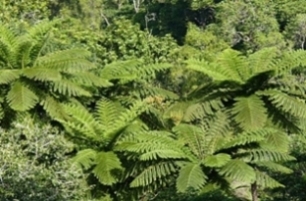
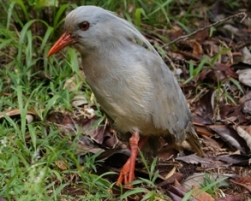
Left: Tree fern
Right: Kagu (Rhynochetos jubatus) © E. Bonnet-Vidal

FIELD TRIP 4:
Mount Aoupinié and Gohapin tribe in the in the Central Chain Mountains - 2h30 from Nouméa
During this field trip you will discover the Mont Aoupinié's west
slope and the actions of ecological restoration led by one of the
tribes who live at the foot of the mountain and the WWF. As a large
patch of rainforest in the heart of New Caledonia, the Aoupinié
is threatened by recurrent bush fires, forest exploitation and impacts
of invasive species (deers, feral pigs, …). About ten years ago,
the Gohapin tribe and the WWF set a wide programme of reforestation,
relied on community nurseries, reduction of bush fire occurrence,
and actions for the ecotourism's development.
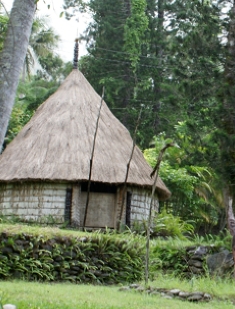
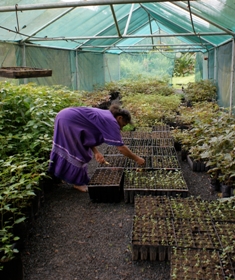
Left: Gohapin chief's hut
Right: Tribe's native species nursery
|


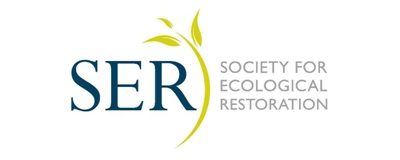
 Along
with sightseeing, you will be able to meet local people and specialists
and to learn about their will to protect their environment. You
will also be pleased to meet New Caledonia's biodiversity hotspot
world famous native flora (Amborella) and many more.
Along
with sightseeing, you will be able to meet local people and specialists
and to learn about their will to protect their environment. You
will also be pleased to meet New Caledonia's biodiversity hotspot
world famous native flora (Amborella) and many more.



 FIELD
TRIP 2: Koniambonickel Mine in the western north coast - 3h
from Nouméa
FIELD
TRIP 2: Koniambonickel Mine in the western north coast - 3h
from Nouméa




